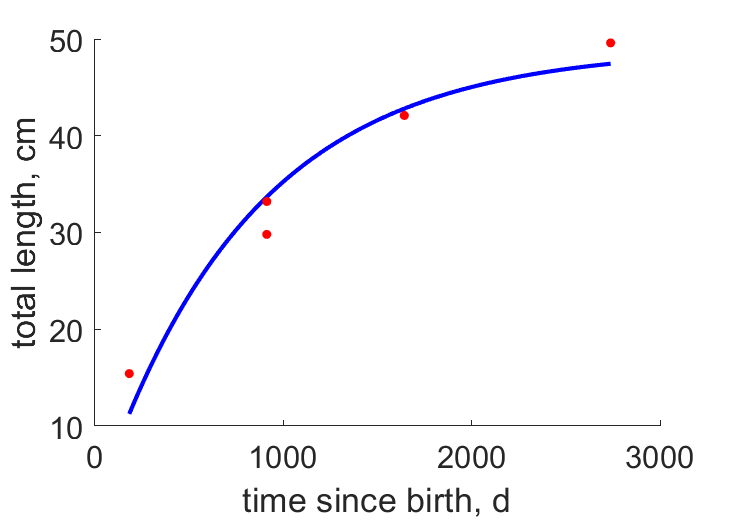Predictions & Data for this entry
| Model: std | climate: A | migrate: | phylum: |
| COMPLETE = 2.5 | ecozone: TN | food: bjTva, jiCi, jiSvf | class: |
| MRE = 0.071 | habitat: 0iFr, 0iFc | gender: Dg | order: |
| SMSE = 0.010 | embryo: Fv | reprod: O | family: |
Zero-variate data
| Data | Observed | Predicted | (RE) | Unit | Description | Reference |
|---|---|---|---|---|---|---|
| aj | 220 | 266.9 | (0.213) | d | age at metam | Wiki |
| tp | 488 | 415.1 | (0.1493) | d | time since metam at puberty | guess |
| am | 3650 | 3656 | (0.001634) | d | life span | guess |
| Lb | 1.7 | 1.703 | (0.001766) | cm | total length at birth | guess |
| Lj | 13.68 | 14.82 | (0.08329) | cm | total length at metam | guess |
| Lp | 30 | 29.26 | (0.02483) | cm | total length at puberty for females | guess |
| Lpm | 28 | 27.86 | (0.004936) | cm | total length at puberty for males | guess |
| Li | 55 | 51.38 | (0.06576) | cm | ultimate total length | Wiki |
| Wwj | 6 | 5.104 | (0.1494) | g | wet weight at metam | guess |
| Wwp | 34.6 | 39.26 | (0.1348) | g | wet weight at puberty | guess |
| Wwi | 213 | 212.7 | (0.001242) | g | ultimate wet weight | guess |
| Ri | 0.01918 | 0.01979 | (0.03177) | #/d | maximum reprod rate | guess |
Uni- and bivariate data
| Data | Figure | Independent variable | Dependent variable | (RE) | Reference |
|---|---|---|---|---|---|
| tL |  | time since birth | total length | (0.06685) | MeasWilk1998 |
Pseudo-data at Tref = 20°C
| Data | Generalised animal | Typhlonectes natans | Unit | Description |
|---|---|---|---|---|
| v | 0.02 | 0.02441 | cm/d | energy conductance |
| kap | 0.8 | 0.9998 | - | allocation fraction to soma |
| kap_R | 0.95 | 0.95 | - | reproduction efficiency |
| p_M | 18 | 23.07 | J/d.cm^3 | vol-spec som maint |
| k_J | 0.002 | 0.002 | 1/d | maturity maint rate coefficient |
| kap_G | 0.8 | 0.8012 | - | growth efficiency |
Discussion
- Males are assumed to differ from females by E_Hp only
Facts
- Ovoviviparous, young feed on maternal glandular secretions, scraping the inside of the oviduct (Ref: Wiki)
- Two vesiculous gills are present at the back of the dorsum of the head at birth; these fall off 24-48 h after birth and leave-a white scar that fades after some weeks (Ref: ExbrDels1985)
Bibliography